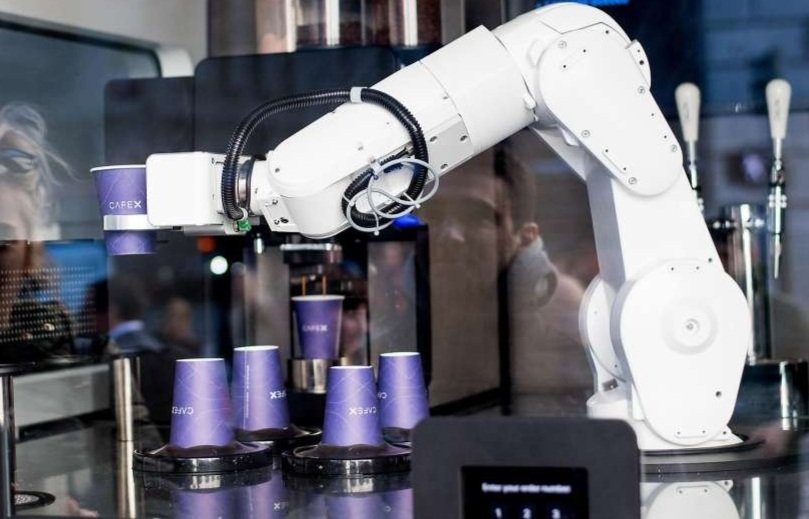
Technology is pervasive. Having spent over two decades in the tech world, I am certain that every industry will be affected by technology one way or the other. However, I was not sure how much will it impact the world of coffee making. Will the future of coffee making be driven by technology? Would AI and robots run our coffee bars? Should we fear technology displacing the baristas? Though it will and may, the idea of being served by a robotic arm rather than a human barista with whom I can connect, chit-chat, and exchange stories is disappointing. But then, who knows we will be even able to converse with the robots satisfying even those who crave caffeine.
In this article, let us explore the future of coffee making and where is science and technology leading us.
Table of Contents
- How has technology affected coffee machines?
- What technologies are used in coffee farming?
- Will machines replace baristas? Few popular barista bots
- Conclusion
How has technology affected the coffee machines?
One can argue that technology has already started impacting the coffee-making process with continuous innovation happening in the segment of coffee dispensing machines, to automatic espresso machines.
Let us look at a modern automatic espresso machine and you will find it embedded with a plethora of technology elements. But the commercialized innovations such as electric pumps, automatic grinders, user-controlled shot-making capability, and integrated milk frothing systems – all are great and required for increasing efficiency, productivity, and quality.
But those in principle are making the job of a barista easier not necessarily replacing them.
However, embedding a mini-computer in a coffee machine is just the beginning. Today, it helps with user control, temperature monitoring & control, pressure regulation, dosing of beans (controlling the size of the ground beans), monitors the brewing time, can provide maintenance reminders, and even help use energy efficiently.
These are important components that have driven the coffee revolution forward making it as convenient as possible for the consumer reducing their wait times!
Single-serve coffee maker
The breakthrough in single-serve coffee came in the 1990s when Keurig introduced the K-cup system. When John Sylvan invented K-Cups, he had no idea the kind of revolution he was brewing. From a technology point of view, it was a perfect mixture of embedding the right amount of technologies at the right price point and eventually making it an affordable entry point.
Ease of use was probably the most important driving factor in its adoption
At the core of every modern single-serve coffee maker is the traditional engineering elements of the pump, check valve system, heating elements (created through electrical resistance), and some neat mechanical & industrial designs.

These single-serve coffee makers can be integrated with wifi, Bluetooth, and even smart IOT sensors to make it as intelligent as possible. They can be highly calibrated by adjusting the water ratio, coffee grain sizes, and coffee temperatures.
What technologies are used in coffee farming?
Another key impact of technology can be seen in coffee farming. A few areas of usage are:
- Usage of Unmanned Aerial Vehicles (UAW)Farmers have begun using drones to replace manual monitoring of crops. With the aid of a camera attached to the drone, farmers can get wider and narrower coverage of their fields understanding the health of crops, the spread of pests or diseases, etc.. They have been also using drones to spray pesticides – overall increasing efficiency and decreasing labor costs
- Usage of Sensors (IoT) in agricultureFarmers have been using sensors to monitor environmental variables such as soil temperature, humidity, and moisture content. Even sensing the presence of certain gases in the soil has been beneficial for the crops. Scientists are recommending remote satellite sensing techniques for mapping coffee plantations and understanding how they drive landscape dynamics. Active sensors https://www.mdpi.com/2073-4395/12/9/2118 have been also introduced to monitor crop yield
- Weather forecasting climate is becoming more and more unpredictable, and weather forecasting based on environmental factors and mathematical models is becoming key for the survival of coffee farmers. The technology is being developed by Sucafina in partnership with satellite tracking companies Trade in Space (TIS) and Global Risk Assessment Service (GRAS) to identify where deforestation is happening in the global coffee supply chain

Will machines replace baristas?
One would argue that the invention of robotic arms and developments in this field do create a significant threat to the baristas (humans). The robotic arm of today has come a long way since its first invention in 1951 by Devol and Engleberger. The robotic arms of today are fast, reliable, and sage.
Most of these robotic arms have ~six joints connecting seven sections, which in turn are controlled by computers. Thus the arm can be positioned precisely mimicking the ‘hand’. If you can think of a Barista as a function of ‘hand’ and ‘brain’ with coffee knowledge, the computers have absorbed the complex recipes of coffee coffee-making part, while the robotic arm takes the function of ‘hand’. So, machines can indeed replace baristas.
Investment has poured in this technology and there are a few startups who are trying to address this domain.
“In today’s day and age, hiring baristas 50-60 hours a week to make coffee is just crazy”
— SILICON VALLEY INVESTOR
Popular startups looking to replace baristas
- Café X
- Founded: 2015
- Location:: San Francisco
- Main Tech: Robotic Arms & Automation
- Successful: Moderate
- Cafe X is a robotic coffee bar that can make a variety of coffee drinks, including espresso, cappuccinos, and lattes. Customers can place orders using a mobile app or a kiosk and watch the robotic arm prepare their coffee. They have over $6M in sales and have raised upwards of $10M in venture capital from Silicon Valley investors. The kiosk can make up to 100 drinks per hour, clearly challenging any efficient barista!
- Briggo Coffee Haus
- Founded:: 2011
- Location:: Austin
- Main Tech: Smart Automation
- Successful: Low
- Briggo is an Austin-based company, with an automated coffee kiosk that serves a wide range of coffee beverages. It allows customers to customize their drinks through a mobile app and then pick up their coffee from the kiosk. Investment of over $20M has poured into this venture. https://thespoon.tech/briggos-coffee-haus-becomes-costa-coffee-baristabot/
- TopBrewer
- Founded:: 2013 (at least
- Location:: New Jersey
- Main Tech: Smart Automation
- Successful: Moderate
- TopBrewer is a coffee machine that can be integrated into various settings, such as offices, and hotels, and is built into countertops. It is controlled through a mobile app and can prepare a variety of coffee and tea beverages. It does not use any robotic arms and will not replace baristas but is more challenging the automatic coffee machines or single-serve machines.
- Rozum Cafe
- Founded:: 2016
- Location: Poland
- Main Tech: Robotic Arms
- Successful: Moderate
- Rozum has its roots as a robotics company. The coffee project started in 2019. The very first prototype was made at the time: a robotic arm PULSE using a Saeco coffee machine to treat everyone with fine espresso
- Brobee
- Founded: 2020
- Location: Portland
- Main tech: Robotic Arms
- Successful: Low
- This Oregon-based robotic coffee startup probably has the coolest video. https://youtu.be/h0OnBzO_yk8 It uses two robotic arms and looks impressive as they are self-contained taking orders from the users. Unfortunately, it does not seem like the company has made progress with more locations and seems to have shut down or considerably slowed its progress.
Conclusion
Technology has no doubt impacted the coffee industry in a variety of ways starting from the coffee machines, to utilizing sensors and IoT devices in coffee farming. These technical elements have been limited to mechanical, and industrial innovations – such as press, heat pumps, motors, and computing technologies with embedded microcontrollers to chips making the coffee machines ‘smart’ and have been quite successful. However, the final frontier lies in creating a ‘human-less’ coffee shop experience, and in my analysis, it has just begun but had still some ways to go.
